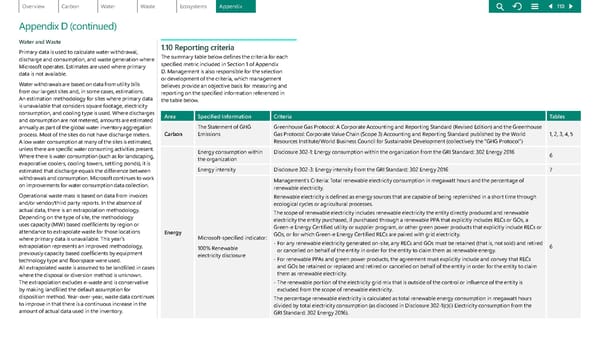Appendix D (continued) Water and Waste Primary data is used to calculate water withdrawal, disc harge and consumption, and waste generation where Microsoft operates. Estimates are used where primary data is not available. Water withdrawals are based on data from utility bills fro m our largest sites and, in some cases, estimations. An estimation methodology for sites where primary data is unavailable that considers square footage, electricity consumption, and cooling type is used. Where discharges and consumption are not metered, amounts are estimated annually as part of the global water inventory aggregation process. Most of the sites do not have discharge meters. A low water consumption at many of the sites is estimated, unless there are specific water consuming activities present. Where there is water consumption (such as for landscaping, evaporative coolers, cooling towers, settling ponds), it is estimated that discharge equals the difference between withdrawals and consumption. Microsoft continues to work on improvements for water consumption data collection. Operational waste mass is based on data from invoices and /or vendor/third party reports. In the absence of actual data, there is an extrapolation methodology. Depending on the type of site, the methodology uses capacity (MW) based coefficients by region or attendance to extrapolate waste for those locations where primary data is unavailable. This year’s extrapolation represents an improved methodology, previously capacity based coefficients by equipment technology type and floorspace were used. All extrapolated waste is assumed to be landfilled in cases where the disposal or diversion method is unknown. The extrapolation excludes e-waste and is conservative by making landfilled the default assumption for disposition method. Year-over-year, waste data continues to improve in that there is a continuous increase in the amount of actual data used in the inventory. 110 1.10 Reporting criteria The summary table below defines the criteria for each specified metric included in Section 1 of Appendix D. Management is also responsible for the selection or development of the criteria, which management believes provide an objective basis for measuring and reporting on the specified information referenced in the table below. Area Specified Information Criteria Table s Carbon The Statement of GHG Emis sions Greenhouse Gas Protocol: A Corporate Accounting and Reporting Standard (Revised Edition) and the Greenhouse Gas P rotocol: Corporate Value Chain (Scope 3) Accounting and Reporting Standard published by the World Resources Institute/World Business Council for Sustainable Development (collectively the “GHG Protocol”) 1, 2, 3, 4, 5 Energy consumption within the organization Disclosure 302-1: Energy consumption within the organization from the GRI Standard: 302 Energy 2016 6 Energy intensity Disclosure 302-3: Energy intensity from the GRI Standard: 302 Energy 2016 7 Energy Microsoft-specified indicator: 100% Renewable electricity disclosure Management's Criteria: Total renewable electricity consumption in megawatt hours and the percentage of ren ewable electricity. Renewable electricity is defined as energy sources that are capable of being replenished in a short time through ecological cycles or agricultural processes. The scope of renewable electricity includes renewable electricity the entity directly produced and renewable electricity the entity purchased, if purchased through a renewable PPA that explicitly includes RECs or GOs, a Green-e Energy Certified utility or supplier program, or other green power products that explicitly include RECs or GOs, or for which Green-e Energy Certified RECs are paired with grid electricity. - For any renewable electricity generated on-site, any RECs and GOs must be retained (that is, not sold) and retired or cancelled on behalf of the entity in order for the entity to claim them as renewable energy. - For renewable PPAs and green power products, the agreement must explicitly include and convey that RECs and GOs be retained or replaced and retired or cancelled on behalf of the entity in order for the entity to claim them as renewable electricity. - The renewable portion of the electricity grid mix that is outside of the control or influence of the entity is excluded from the scope of renewable electricity. The percentage renewable electricity is calculated as total renewable energy consumption in megawatt hours div ided by total electricity consumption (as disclosed in Disclosure 302-1(c)(i) Electricity consumption from the GRI Standard: 302 Energy 2016). 6
 Environmental Sustainability Report | Microsoft Page 109 Page 111
Environmental Sustainability Report | Microsoft Page 109 Page 111